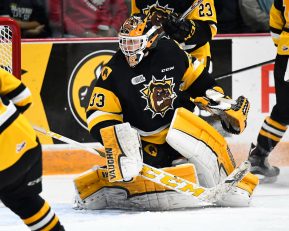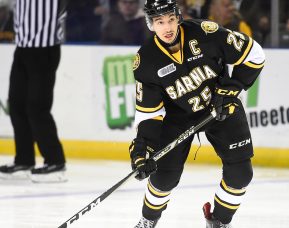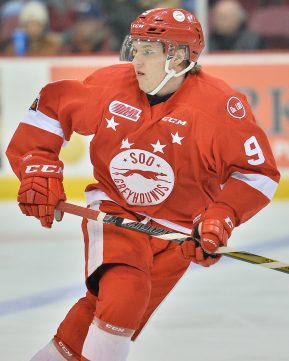Frontrunners Load Up at the Trade Deadline
Showdown in the East Division
This year’s OHL trade deadline was exceptionally busy with over 40 players and 70 draft picks moved. OHL fans have become accustomed to the proverbial arms race with many teams in the Western Conference loading up at the deadline each year. So it was remarkably refreshing to see two Eastern Conference teams step up and be among the league’s top buyers. And it just so happens that both of these teams, Hamilton and Kingston, play in the East Division.

Kaden Fulcher of the Hamilton Bulldogs. Photo by Aaron Bell/OHL Images
Hamilton has been the cream of the crop in the Eastern Conference for the majority of this season. Thanks to some great goaltending from Detroit prospect Kaden Fulcher, a deep defensive unit, and balanced scoring, the Bulldogs have held the lead atop the Conference for several weeks and have held a place in the CHL Top 10 for seven weeks running.
It was also the Bulldogs who struck early on, capitalizing on a hot start, by bringing in forwards Nic Caamano (Dallas) and Ryan Moore from Flint in a blockbuster deal. These two helped Hamilton increase their division lead over Kingston to double digits as we approached the deadline. But it didn’t stop Hamilton from continuing to build by adding defenders Riley Stillman (Florida) and Nic Mattinen (Toronto), in addition to London’s Robert Thomas (St. Louis). The Thomas add, in particular, is huge. The gold medalist from the most recent World Junior Hockey Championships is a dynamic offensive player who also happens to be terrific in all three zones and can play in all situations. He gives the Bulldogs one of the top centerman in the entire OHL.
However, do not tell the Frontenacs that the division is locked up already. With overager and Hurricanes prospect Jeremy Helvig in his last OHL season, Kingston decided to go all in and make a run for an OHL Championship. They owe it to their dedicated fan base, having lost in the Conference Semi-finals the last two years. In fact, Kingston has never made a trip to the OHL Finals and hope to re-write that part of history this year.

Gabriel Vilardi of the Kingston Frontenacs. Photo by Terry Wilson / OHL Images.
Kingston brought in star forwards Gabe Vilardi (Los Angeles), Max Jones (Anaheim), and Cliff Pu (Buffalo) to insulate offensive dynamo Jason Robertson (Dallas). They also added former exceptional status grantee Sean Day (NY Ramgers) to an already large, and menacing blueline. The addition of Vilardi was a risky one, considering he had yet to play this year due to back surgery. But the early results have been fantastic as the Kings’ first rounder is showing little rust and has 14 points in 9 games.
As this article is being written, Hamilton’s lead over Kingston in the division remains double digits with just over 20 games left to play. The two teams will meet only one more time this regular season, on Friday, February 23rd in Kingston. Even if the division may be a tall order for the Frontenacs, they look poised to overcome Barrie or Niagara (who are battling for the Central Division) to take that coveted 3rd spot in the Conference heading into the playoffs. That would mean, pending no upsets, we could see a Hamilton/Kingston Eastern Conference final and that would be one heck of a series.
Catching Up to SSM in the West
Meanwhile, the Western Conference also saw a few teams loading up, in this case to try and catch the Soo Greyhounds atop the standings. While the regular season crown may be a far-fetched goal, Sarnia and Kitchener each brought in a host of talented players in order to push Sault Ste. Marie come playoff time.

Jordan Kyrou of the Sarnia Sting. Photo by Aaron Bell/OHL Images
Sarnia has been one of the league’s most surprising teams this season. Thanks to superstar Jordan Kyrou (St. Louis), who was leading the league in scoring before leading Canada in scoring at the World Junior Championships, and OA goaltender Justin Fazio, the Sting have been pushing the Greyhounds all season long. It was becoming apparent (especially with Kyrou and Adam Ruzicka [Calgary] away at the WJC’s) that their depth just was not at the same level as the Soo’s. So before their hot start fizzled away, the team went out and brought in Jonathan Ang (Florida), Michael Pezzetta (Montreal), and Cam Dineen (Arizona). This gives them two terrific scoring lines, and the puck moving defender and PP Quarterback that they sorely lacked.
Kitchener, on the other hand, has had a firm grasp on the Midwest Division all season, thanks to the disappointing starts of London and Owen Sound and the rebuild of the Erie Otters. This was despite not having a ton of confidence in their goaltending. It has been the worst kept secret in the league that the Rangers were out to improve their goaltending at this year’s deadline. Fans were shocked when it was not Michael Dipietro (Vancouver), Dylan Wells (Edmonton), or another star netminder brought in, but overager Mario Culina, who had actually spent time with Ryerson University (of USports) earlier this year after he failed to catch on with an OHL team this offseason. Yet the early results have silenced critics and arm-chair scouts. Culina remains perfect with the Rangers and even sported a shutout streak of over 150 minutes recently.
The Rangers also brought in hulking center Logan Brown (Ottawa), veteran defender Austin McEneny, and power forward Givani Smith (Detroit) to ensure that they hold off all on-comers in the division.
The question is, even with the moves Kitchener and Sarnia have made to shore up any weaknesses, are they in the same league (metaphorically of course) as the Greyhounds?
Greyhounds The Team to Beat
That, of course, brings us to the Greyhounds, the top ranked team in the entire CHL, and owners of a 23 game win streak earlier this season. You would be hard pressed to find a single person who believes that any other team in the OHL is the frontrunner for this year’s OHL Championship, even with the bevy of deals made by other competitors.

Rasmus Sandin of the Sault Ste. Marie Greyhounds. Photo by Terry Wilson / OHL Images.
The Greyhounds boast the league’s current leading scorer in Morgan Frost (Philadelphia). They have the league’s second leading goal scorer in Boris Katchouk (Tampa Bay). They have two of the highest scoring defenders in the league (points per game) in Conor Timmins (Colorado) and Rasmus Sandin (2018). They have the current goals against average leader in Matthew Villalta (Los Angeles) manning the pipes. They have the league’s second best powerplay at over 25%. They also have a remarkable 17 shorthanded goals so far (the Saginaw Spirit have 25 powerplay goals this year as a comparison). Get the drift yet? This is one heck of a dominant team.
Yet, the Hounds were not content to stand pat at this year’s trade deadline. They acquired veterans Taylor Raddysh (Tampa Bay) and Jordan Sambrook (Detroit) from the Erie Otters, who have a combined 89 games of playoff experience. This includes winning an OHL Championship last season. Raddysh showcased terrific chemistry with Boris Katchouk at this year’s World Juniors and will make an already stacked powerplay that much stronger.
The OHL playoffs will begin the week of March 19th and it will be then, and only then, when we will find out if a team can usurp the Greyhounds; if all those moves and all the young assets jettisoned out were worth it. But one thing is certain, the favorite to represent the OHL in Regina at this year’s Memorial Cup is still Sault Ste. Marie.
Don’t Sleep on
Steelheads look to Repeat on Last Year’s miracle second half
Last year, the Mississauga Steelheads were the near unanimous selection to take the OHL’s Eastern Conference in preseason polls. Yet at midseason, they found themselves near the bottom of the Conference. Miraculously, they exploded in the second half, played up to their capability, took the Central Division, and ultimately the Eastern Conference title come playoff time.

Michael McLeod of the Mississauga Steelheads. Photo by Aaron Bell/OHL Images
This year, the Steelheads were picked by many to repeat as Eastern Conference champs and Division winners. Yet again, they had a disappointing start to the year and find themselves near the bottom of their division. Many expected them to sell off a few key assets (like Michael McLeod [New Jersey] or Nic Hague [Vegas]) and rebuild. Instead they stayed the course, made a few minor acquisitions (like Mathieu Foget, Reagan O’Grady, and Cole Carter), and are suddenly blazing up the standings again. Since the Foget deal, the Steelheads are 6-2, with victories against Sault Ste. Marie (ending the latter’s 23 game win streak), Kitchener, Kingston, and division leaders Barrie.
Do they have another remarkable comeback in them? I would say that it is unlikely. Last year, the Central Division was atrocious with Mississauga as the only team above .500. This year, the Barrie Colts and Niagara IceDogs are playing excellent hockey and made some key acquisitions themselves. The better question is, do any of these Eastern Conference contenders want to see the Steelheads in the opening round(s) of the playoff? A very likely scenario could be a first round match-up between Kingston and Mississauga, or a second round match-up with Hamilton. And if the Steelheads continue to close out the regular season on a high note, we may not even be able to consider them as underdogs.
Owen Sound Attack Better than standings show
Another team that has underwhelmed this year is the Owen Sound Attack. They were able to return, fully intact, one of the league’s most dangerous lines from last year; Nick Suzuki (Vegas)-Jonah Gadjovich (Vancouver)-Kevin Hancock. And even though they were losing their captain, Santino Centorame, and their starting goaltender, Michael McNiven (Montreal), the expectation was that they had the depth to counteract those losses.
 But it’s been a frustrating year for the Attack and its fans. Injuries have been an issue, especially with Hancock and Gadjovich both missing significant time. And finding a replacement for McNiven has been near impossible. They picked up Zach Bowman from Sudbury this offseason, but he left the team at midseason for personal reasons. Then they recently acquired Olivier Lafreniere from Ottawa, but he has since injured his groin and is out long term. So the reigns have been given to 17 year old rookie Mack Guzda.
But it’s been a frustrating year for the Attack and its fans. Injuries have been an issue, especially with Hancock and Gadjovich both missing significant time. And finding a replacement for McNiven has been near impossible. They picked up Zach Bowman from Sudbury this offseason, but he left the team at midseason for personal reasons. Then they recently acquired Olivier Lafreniere from Ottawa, but he has since injured his groin and is out long term. So the reigns have been given to 17 year old rookie Mack Guzda.
However, the Attack are finally healthy again with Hancock returning to the lineup recently. They went out and got Brett McKenzie (Vancouver) from North Bay to improve their second line. Import (and Flyers pick) Maksim Sushko is playing terrific hockey since returning from the World Juniors.  And Aidan Dudas (2018) and Sean Durzi are in the middle breakout seasons as stars in the OHL. The team looks to be turning a corner and certainly has the talent and experience to do damage in the playoffs, even if they draw one of the big three (Sault Ste. Marie, Kitchener, or Sarnia) in the first round. Like Mississauga, this is a potentially dangerous team come playoff time; and one capable of pulling off an upset.
And Aidan Dudas (2018) and Sean Durzi are in the middle breakout seasons as stars in the OHL. The team looks to be turning a corner and certainly has the talent and experience to do damage in the playoffs, even if they draw one of the big three (Sault Ste. Marie, Kitchener, or Sarnia) in the first round. Like Mississauga, this is a potentially dangerous team come playoff time; and one capable of pulling off an upset.
Re-Tooling to Fight Another Day
London and Windsor start the cycle
Having already discussed many of the contenders loading up at this year’s deadline, one had to ask, “where are all these players coming from?” The answer this year is rare, as perennial contenders the London Knights and Windsor Spitfires sold off assets. The Knights traded Robert Thomas, Max Jones, Cliff Pu, and Sam Miletic (Pittsburgh), while the Spitfires traded Logan Brown, Gabe Vilardi, Sean Day, and Austin McEneny. While it has not been uncommon for these two to sell off assets, it has been rare for it to occur in the same year. We have to go back to the 2001-02 season (16 years ago) to see neither London nor Windsor with home ice advantage in the opening round of the playoffs. With the Knights and Spitfires currently sitting 4th and 6th (respectively) right now, that is an entirely possible outcome.
Even then, this is not a normal sell-off. We’re looking at two firmly established playoff teams with a chance of finishing in the top four of the Conference, selling off assets. The question is...why? And the answer is the reason why London and Windsor have remained such competitive forces in the OHL over the last 15 years (they combine for five of the last six OHL Memorial Cup victories). Spitfires GM Warren Rychel gave an interview recently where he was asked about the concept of re-tooling. His response was that it made no sense to be in limbo. You either need to be competitive for first, and if you won’t be, then you might as well finish lower in the standings and get assets that can help you finish first again in the near future. This is the credo that the Knights and Spitfires have lived by and it is the reason why they have been able to win so many championships in recent years.

Curtis Douglas of the Windsor Spitfires. Photo by Terry Wilson / OHL Images.
This year is a perfect example. London and Windsor trade off their best veteran players and pick up three outstanding young players (each), in addition to a boatload of high end draft picks. These young players (like Nathan Dunkley [2018] or Curtis Douglas [2018]) are already good players and they slide into the line-up and contribute. Both London and Windsor now have three recent first round picks (among the top 2001 born players in the province) in their lineups, allowing them to grow together and improve under the tutelage of excellent coaching staffs. With a boatload of draft picks, they also are not afraid to take a chance on the top American players available in hopes that they eventually commit to the Ontario Hockey League. And you better believe that with high selections at this year’s Import Draft, both of these franchises will be selecting high end talents.
That is what separates the Knights and Spitfires from many of the other franchises in the OHL. They hate mediocrity. They aspire for a Championship. And if they do not feel that they can achieve that, they cut and run and bring in as many future assets as they can, even if it means an early playoff exit. It also might mean trading off players who still have potential service time, like Robert Thomas or Gabe Vilardi. If these two return to the OHL next year, they will be among the better players in the league. However, it is also possible that they make their respective NHL rosters and then London and Windsor would have received nothing for them (like the Guelph Storm, who are still feeling the effects of not getting anything for Robby Fabbri a few years ago after he left early for St. Louis).
Other OHL teams become obsessed with merely making the playoffs in hopes that anything can happen. But the way teams load up (call it the NBA super team effect), it’s a pipe dream for most. Would you not rather bring in three quality young players and maybe lose in the first round, than keep your veterans, get swept in the second round and then lose them for nothing when they graduate?
The Race for Quinton Byfield
Erie, Sudbury, & Flint battle for the highly touted youngster
As many teams hunt for a conference crown, division title, and playoff spot, an equally important battle is occurring at the bottom of the OHL standings; the race for the Jack Ferguson recipient. And this year, the crown jewel appears to be quite a special player. His name is Quinton Byfield and he’s a 6-3”, 200lbs center who seems destined to become the league’s next true superstar. Many consider him to be one of the better talents to come out of the province in recent years.
The race for Byfield is occurring between three teams, all of whom have different storylines. Those three teams are the Erie Otters, Sudbury Wolves, and Flint Firebirds.
Erie is rebuilding after four straight years of excellence on the backs of the likes of Connor McDavid, Dylan Strome, and Alex DeBrincat. This includes an OHL Championship last year. A player like Byfield would accelerate the rebuild nicely and spoil the Otters’ fanbase yet again with another potential generational talent.
Sudbury, on the other hand, is stuck in what seems to be a perennial rebuild. They’ve drafted first, second, and seventh the last three years and once again find themselves at the bottom. With new ownership, and new management in place, things are finally starting to look up for this once storied franchise. A dominant power center like Byfield would be just what the doctor ordered to get this team back near the top of the standings, perhaps even as early as next year.
Lastly, Flint is still looking to escape the shadow of the controversy that dominated their inaugural season. 2016/17 saw them take a significant step forward but this year has been a step in the wrong direction and suddenly the team is rebuilding again (after trading away top talent like Nic Caamano, Ryan Moore, and Nic Mattinen). But this is a very talented young team that is bound to explode either next year or the year after. Forgive me if you have heard this before, but Quinton Byfield is the star this franchise needs in order to climb out of mediocrity.
A Broken System
OHL Teams Will Soon Trade for the Unborn
As previously mentioned, over 70 draft picks changed hands this trade deadline. Due to crazy circumstances, over half of those picks are from beyond the year 2020. This includes the movement of draft picks from the year 2026, 2027, and 2028. Yes, that is correct. A 5 year old was traded this January.
For those that find this absurd, you would be correct. In the Western Hockey League and Quebec Major Junior Hockey League, teams cannot move draft picks that far in advance. And unlike the OHL, teams are also permitted to move their first round draft picks. Let us examine some major moves in all three leagues this trade deadline to compare the effect this has. Kale Clague moved for two quality young players, two first round picks, and a 2nd round pick. Drake Batherson went for three solid young players and a first round pick. Robert Thomas went for a top young player, four 2nd rounders and two 3rd rounders. Because of the high prices and inability to move first rounders, teams like Hamilton and Kingston are almost completely devoid of 2nd round picks for the foreseeable future. Hamilton has two 2nd rounders this year, but then does not own one until 2026 after that. Kingston does not have a 2nd round pick until 2026.
The prices being paid for these players who are essentially rentals, has also spiraled out of control. Let us examine some past deadline deals in the OHL for perspective.
In 2012, the London Knights and Niagara IceDogs battled for an OHL Championship. The Knights brought in rugged two-way star Austin Watson from Peterborough at the deadline at the cost of a moderate young player, two 2nd round picks, and a 4th. Meanwhile, Niagara brought in power forward Brett Ritchie at the cost of three 2nd round picks.
In 2000, perhaps the largest trade in OHL history up until that point occurred and that was the trade of Jason Spezza from Mississauga to Windsor. In return, Mississauga got four players (none could be considered among Windsor’s top young players, save maybe Ryan Courtney), a 2nd round pick and a 6th round pick.
Needless to say, things are changing and these trades are getting out of hand. We’re seeing upwards of six quality draft picks in addition to a team’s top young player changing hands in exchange for one player.
Just what the OHL can do to rectify this remains to be seen, if they wish to rectify it. Would allowing teams the option of trading first rounders lower the cost? What about putting a restriction on how far in advance draft picks can be moved? Regardless, it no longer makes sense for the OHL to differ from the WHL and QMJHL in accordance with transaction limitations. This broken system needs to be fixed. How soon before we get a draft pick trading hands where said future draft pick is not even born yet?

















